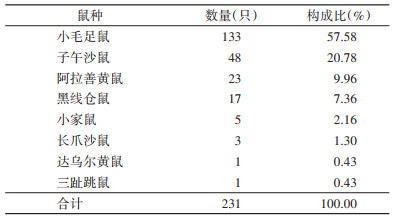扩展功能
文章信息
- 郭承德, 秦萌, 韩立亮, 付和平, 刘宝玉, 苏元红, 肖彩虹, 阿拉塔, 蔺永生, 段锐, 王登云, 乔靖然
- GUO Cheng-de, QIN Meng, HAN Li-liang, FU He-ping, LIU Bao-yu, SU Yuan-hong, XIAO Cai-hong, Alata, LIN Yong-sheng, DUAN Rui, WANG Deng-yun, QIAO Jing-ran
- 内蒙古西部农区基于智能物联网的鼠害监测系统待机时间及影响因素分析
- A rodent surveillance system based on intelligent internet of things in western agricultural area of Inner Mongolia Autonomous Region, China: Standby time and associated correlation analysis
- 中国媒介生物学及控制杂志, 2023, 34(5): 686-690
- Chin J Vector Biol & Control, 2023, 34(5): 686-690
- 10.11853/j.issn.1003.8280.2023.05.018
-
文章历史
- 收稿日期: 2023-03-07
2 全国农业技术推广服务中心, 北京 100125;
3 青岛清数科技有限公司, 山东 青岛 266000;
4 内蒙古农业大学草原与资源环境学院/内蒙古自治区高等学校草地啮齿动物生态学与鼠害控制重点实验室, 内蒙古 呼和浩特 010011;
5 内蒙古农业大学草地资源教育部重点实验室, 内蒙古 呼和浩特 010011;
6 内蒙古巴彦淖尔市现代农牧事业发展中心, 内蒙古 临河 015000;
7 中国林业科学院沙漠林业实验中心, 内蒙古 磴口 015200
2 National Agro-tech Extension and Service Center, Beijing 100125, China;
3 Qingdao Qingshu Technology Co., Ltd., Qingdao, Shandong 266000, China;
4 College of Grassland Resources and Environment, Inner Mongolia Agricultural University/Key Laboratory of Grassland Rodent Ecology and Rodent Control, Inner Mongolia University, Hohhot, Inner Mongolia 010011, China;
5 Key Laboratory of Grassland Resources of Ministry of Education, Inner Mongolia Agricultural University, Hohhot, Inner Mongolia 010011, China;
6 Modern Agriculture and Animal Husbandry Development Center of Bayannur City, Linhe, Inner Mongolia 015000, China;
7 Experimental Center of Desert Forestry, Chinese Academy of Forestry, Dengkou, Inner Mongolia 015200, China
巴彦淖尔市是农业农村部国家级农区鼠害长期定位监测点之一,对于反映内蒙古自治区(内蒙古)西部农区鼠情具有重要参考作用。2018年以前,巴彦淖尔市长期采用以夹捕法为主的传统人工监测方法,基于大数据的物联网智能监测系统2018年6月起在内蒙古农区鼠害监测实践中开始应用。该系统可以实现害鼠影像数据的自动采集、计算分析,并对鼠害个体进行智能识别分类[1-3]。2019年9月应用该系统在磴口县农区开展了鼠害监测,并首次提出基于智能物联网鼠害监测的待机时间概念及15 d的参考值[2],目前尚未见有相关报道[4-7]。本文将待机时间的研究扩展至巴彦淖尔市,对各智能终端在第1只鼠同一鼠种、县(旗)等不同层面,待机正常运行天数、过机害鼠数量、鼠密度、待机时间等分别进行统计分析,以明确鼠密度与待机时间的关系。
1 材料与方法 1.1 试验地 1.1.1 巴彦淖尔市概况巴彦淖尔市地处我国正北方,位于内蒙古西部,总面积6.51万km2,北与蒙古国接壤。行政区划辖7个县(旗、区)[8]。中部阴山山脉横贯东西,分布有河套平原、乌拉特草原、乌拉山国家森林公园、乌兰布和沙漠等。属中温带大陆性季风气候[9-10]。
1.1.2 鼠疫疫情风险等级地区划分以1个县(旗)作为1个监测点。4个监测点(磴口县、乌拉特前旗、乌拉特中旗、杭锦后旗),共布设11套(台)终端系统。
根据内蒙古卫生健康委员会2020年5月对57个鼠疫监测县(旗)鼠疫疫情风险级别的划分[11],本研究将未列入57个县(旗)名录的地区,统称为未标示风险等级的地区。由此,乌拉特前旗、乌拉特中旗为高风险地区,磴口县、杭锦后旗为未标示风险等级的地区。2020年乌拉特前旗、乌拉特中旗各发生1例人间鼠疫病例。巴彦淖尔市有啮齿动物6种,隶属于1目3科5属[12]。
1.2 试验设备 1.2.1 设备型号鼠害物联网智能监测系统(VIMS 4.0),由清华-青岛大数据工程研究中心提供,青岛云智环境数据管理有限公司生产,以下简称智能终端。
1.2.2 智能终端运行的3种状态智能终端运行有3种状态,其中电量且(或)信号不正常,不能回传数据的记为异常运行,称为静默状态;电量、信号正常,可回传数据的记为正常运行,称为唤醒状态;其中智能终端接入系统到第1次有害鼠通过的时间记为待机时间[2],即待机正常运行,称为活跃状态。
以此为参考,11套(台)智能终端中,唤醒状态、有效正常运行10套(台),正常运行率90.90%,均为活跃状态。杭锦后旗有1套(台)为静默状态。
由此,本研究统计数据只涉及3个有效县(旗)监测点,其中高风险地区有2个监测点,未标示风险等级的地区有1个监测点(磴口县)。
1.3 试验方法2019年9月-2022年12月按照传统的鼠笼、鼠夹调查规则[13]布设智能终端。在农田生境下,沿着田埂下(靠边、无水)或地边,鼠活动明显的鼠道摆放,进出口需同田地边平行布设[1-2]。根据样地特点,采取固定或可移动方式布设。
1.4 数据采集与处理原始数据来源于鼠害信息网中国鼠害信息数据管理系统。智能监测系统采用计算视频数据方式鉴定鼠种,鉴定依据是采集害鼠影像中的形态学指标[3],鼠种、数量等指标由智能终端自动生成[1-3]。以过机害鼠率表示鼠密度,计算方法参照曾娟等[1]的报道,鼠密度(%)=过机害鼠率(%)=过机害鼠总数/(终端1有效监测天数+终端2有效监测天数+…+监测终端n有效监测天数)×100[1-2];鼠密度等数据由终端系统使用SPSS 19.0软件分析处理,自动生成。
电量正常情况下,智能终端可连续24 h×30 d实时记录,一般4G信号强度 > 14时,间隔1 h回传数据,< 14时可能延迟。以智能终端电量、信号正常的时间记为有效监测时间[2]。
应用Excel 2016软件对各智能终端在第1只鼠同一鼠种、县(旗)及不同风险等级地区(标示风险、未标示风险)等层面,对待机正常运行天数、过机害鼠数量、鼠密度、待机时间等分别进行统计分析,以明确鼠密度与待机时间的相关关系。
本研究对相关程度的划分,以∣r∣≥0.75为强相关,0.50≤∣r∣ < 0.75为中度相关,0.25≤∣r∣ < 0.50为弱相关,∣r∣ < 0.25为基本不相关。
2 结果 2.1 鼠害智能终端监测概况在3个有效监测点、10套(台)有效智能终端,2 730 d的有效监测时间(正常运行总天数)内,共监测到害鼠8种231只,隶属于4科6属。过机害鼠总鼠密度为8.46%只/[d·套(台)](简记为8.46%,下同),按每月30 d计,则害鼠平均活动频率为2.54只/[月·套(台)](简记为2.54只/(月·台),下同)。
10套(台)有效智能终端待机正常运行,正常运行率为90.90%,待机正常运行总天数2 730 d。每套(台)有效智能终端待机时间平均为118.20 d,集中于21~98 d,最短为21 d,最长329 d,待机正常运行天数平均为273 d。
第1套(台)接入系统的智能终端,于2019年9月12日布设在磴口县,2020年5月4日第1只害鼠通过,为子午沙鼠(Meriones meridianus),其待机时间为235 d。
2.2 影响智能终端待机时间的因素 2.2.1 鼠种及优势鼠种数量从高到低排前5位的依次是小毛足鼠(Phodopus roborovskii)、子午沙鼠、阿拉善黄鼠(Spermophilus alaschanicus)、黑线仓鼠(Cricetulus barabensis)和小家鼠(Mus musculus)。小毛足鼠占57.58%,为优势鼠种。见表 1。

|
不同终端的待机时间与鼠密度呈弱相关(r=-0.402)。仅乌拉特中旗植保02(高风险地区)待机时间为21 d,接近此前15 d的暂定参考值[2]。见表 2。

|
第1只鼠包括4种鼠种。在第1只鼠同一鼠种所在各终端层面,不同鼠种平均鼠密度从大到小,排前3位的第1只鼠同一鼠种依次是小家鼠、阿拉善黄鼠和子午沙鼠;平均待机时间从小到大,排前3位的第1只鼠同一鼠种依次是小家鼠、阿拉善黄鼠和子午沙鼠(表 3);平均待机时间与鼠密度呈中度相关(r=-0.634)。

|
平均鼠密度从大到小,排前3位的依次是磴口县、乌拉特中旗和乌拉特前旗;平均待机时间从小到大,排前3位的依次是乌拉特中旗、磴口县和乌拉特前旗(表 4);平均待机时间与鼠密度无相关关系(r=-0.078)。

|
高风险地区待机时间与鼠密度呈弱相关(r=-0.404),未标示风险等级的地区呈中度相关(r=-0.533)。见表 5。

|
以智能终端无接触、安全性等方面的优势,可更加安全、有效地监测鼠密度,是代替人工监测的重要参考。智能终端待机时间研究的现实意义是使智能终端静默状态能尽快转换为唤醒状态,进而变为活跃状态。
本研究未进行智能终端监测视频人工辨别与智能识别的数据比对分析。但在广东省使用同一监测系统,智能识别的准确率达到95.26%[4]。
由于监测点少,且布放的智能终端系统不多,为谨慎起见,本研究未剔除待机时间的极端值。理论上待机时间应小于待机正常运行天数。而本研究4套(台)终端待机时间大于待机正常运行天数,可能是电量、信号不正常,中途中断监测所致。
人为干扰的程度(特别是投放饵料数量、频次)会影响试验结果。待机时间的确定,宜在极少人为干扰状态下进行[2],尽量接近或模拟自然状态,以降低人为因素对害鼠活动的影响。待机时间超过120 d仍无害鼠通过的,不宜再采取固定方式,而应参考人工监测夹捕法等的鼠密度。本研究中智能终端待机时间集中于21~98 d,平均为118.20 d,提示该智能终端可用于鼠密度监测。
本研究各县(旗)智能终端平均待机时间与鼠密度无相关关系,可能是由于乌拉特中旗、乌拉特前旗运行天数、过机害鼠数量、鼠密度偏低,且远小于磴口县所致。
不同风险等级地区待机时间应分别确定。由于本研究中无中、低风险等级地区,暂定选取鼠疫疫情高风险地区,次选未标示风险等级的待机时间。
尽管本研究得出平均待机时间与鼠密度在一定的空间和时间尺度上具有较显著负相关关系的初步结论,但也有不足,主要是运行总天数及过机害鼠数量偏少,标示风险等级地区特别是高风险地区数据较少。对于平均待机时间与鼠密度在较大的空间和时间尺度上的关联程度,还需要在较大的区域及较长试验期内加以考察。
利益冲突 无
| [1] |
曾娟, 韩立亮, 郭永旺, 等. 基于大数据的物联网智能监测系统在农区鼠害监测中的应用效果初报[J]. 中国植保导刊, 2019, 39(7): 28-35. Zeng J, Han LL, Guo YW, et al. Preliminary report on the application effect of IoT intelligent monitoring system based on big data technology for rodent monitoring in agricultural areas in China[J]. China Plant Prot, 2019, 39(7): 28-35. DOI:10.3969/j.issn.1672-6820.2019.07.005 |
| [2] |
郭承德, 姜晓平, 秦萌, 等. 内蒙古西部农区鼠害智能物联网监测效果评价[J]. 中国植保导刊, 2022, 42(6): 36-41. Guo CD, Jiang XP, Qin M, et al. Evaluation on the effect of the internet of things-based intelligent monitoring on rodent infestation in agricultural areas of western Inner Mongolia[J]. China Plant Prot, 2022, 42(6): 36-41. DOI:10.3969/j.issn.1672-6820.2022.06.008 |
| [3] |
郭承德, 姜晓平, 秦萌, 等. 鼠害物联网智能监测系统(VIMS4.0)应用中存在的问题与改进尝试[J]. 农业工程技术, 2022, 42(6): 40-42. Guo CD, Jiang XP, Qin M, et al. Problems and improvement attempts in the application of intelligent monitoring system for rodent infestation in internet of things (VIMS4.0)[J]. Agric Eng Technol, 2022, 42(6): 40-42. DOI:10.16815/j.cnki.11-5436/s.2022.06.013 |
| [4] |
姚丹丹, 黄立胜, 姜洪雪, 等. 广东省农区鼠类物联网智能监测系统的应用研究[J]. 中国媒介生物学及控制杂志, 2022, 33(2): 273-276. Yao DD, Huang LX, Jiang HX, et al. Study on application of IoT intelligent monitoring system for agricultural rodent pests in Guangdong province, China[J]. Chin J Vector Biol Control, 2022, 33(2): 273-276. DOI:10.11853/j.issn.1003.8280.2022.02.020 |
| [5] |
黄清臻, 贾瑞忠, 王旭, 等. 便携智能鼠情监测系统箱的研制与应用[J]. 中国媒介生物学及控制杂志, 2021, 32(3): 344-347. Huang QZ, Jia RZ, Wang X, et al. Development and application of a portable intelligent rodent tele-monitoring system[J]. Chin J Vector Biol Control, 2021, 32(3): 344-347. DOI:10.11853/j.issn.1003.8280.2021.03.017 |
| [6] |
高博, 黄恩炯, 张建庆. 鼠类智能监控系统对家鼠活动规律观察研究[J]. 中国检验检疫, 2019(5): 76-79. Gao B, Huang EJ, Zhang JQ. Observation and study on the activity pattern of house mice by rodent intelligent monitoring system[J]. China Port Sci Technol, 2019(5): 76-79. |
| [7] |
黄清臻, 贾瑞忠, 田志博, 等. 基于物联网的鼠情智能远程监测系统的研制与应用[J]. 中华卫生杀虫药械, 2019, 25(6): 519-522. Huang QZ, Jia RZ, Tian ZB, et al. Development and application of an IoT-based rodent tele-monitoring system[J]. Chin J Hyg Insect Equip, 2019, 25(6): 519-522. DOI:10.19821/j.1671-2781.2019.06.004 |
| [8] |
巴彦淖尔市政府门户网站. 市情概况: 自然地理[EB/OL]. (2022-07-13)[2023-02-15]. https://www.bynr.gov.cn/sqgk/zrdl/. Bayannur city government portal. Cities profiles: Natural geography[EB/OL]. (2022-07-13)[2023-02-15]. https://www.bynr.gov.cn/sqgk/zrdl/. (in Chinese) |
| [9] |
内蒙古新闻网. 经济-专栏-天赋河套: 巴彦淖尔农牧业概况[EB/OL]. (2019-03-04)[2023-02-15]. http://economy.nmgnews.com.cn/system/2019/03/04/012663293.shtml. Inner Mongolia News Network. Economic-Column-Talent Hetao: Bayannur agriculture situation[EB/OL]. (2019-03-04)[2023-02-15]. http://economy.nmgnews.com.cn/system/2019/03/04/012663293.shtml. (in Chinese) |
| [10] |
张静, 张怀念, 毕炜, 等. 巴彦淖尔引种豌豆的气候条件分析[J]. 现代农业, 2018(9): 86-88. Zhang J, Zhang HN, Bi W, et al. Analysis of climatic conditions for the introduction of pea in Bayannur city[J]. Mod Agric, 2018(9): 86-88. DOI:10.3969/j.issn.1008-0708.2018.09.061 |
| [11] |
内蒙古自治区卫生健康委. 内蒙古自治区卫生健康委关于调整内蒙古自治区57个鼠疫监测旗县鼠疫疫情风险级别的批复[EB/OL]. (2020-05-14)[2021-06-15]. http://wjw.nmg.gov.cn/zfxxgk/fdzzgknr/wjzt/202106/t20210615_1621193.html. Inner Mongolia Autonomous Region Health Commission. Reply of Inner Mongolia Autonomous Region Health Commission on adjustment of plague epidemic risk level in 57 plague monitoring banners and counties in Inner Mongolia Autonomous Region[EB/OL]. (2020-05-14)[2021-06-15]. http://wjw.nmg.gov.cn/zfxxgk/fdzzgknr/wjzt/202106/t20210615_1621193.html. (in Chinese) |
| [12] |
苏元红, 王慧敏, 王利军, 等. 巴彦淖尔市农区鼠害的发生规律及其防治技术[J]. 内蒙古农业科技, 2014(2): 67-68. Su YH, Wang HM, Wang LJ, et al. Occurrence regularity and control techniques of rodents in Bayannur agricultural areas[J]. Inner Mongolia Agric Sci Technol, 2014(2): 67-68. DOI:10.3969/j.issn.1007-0907.2014.02.034 |
| [13] |
中华人民共和国农业部. NY/T 1481-2007农区鼠害监测技术规范[S]. 北京: 中国农业出版社, 2008. The Ministry of Agriculture of the People's Republic of China. NY/T 1481-2007 Specification of monitoring on rodent pest in rural areas[S]. Beijing: China Agriculture Press, 2008. (in Chinese) |
 2023, Vol. 34
2023, Vol. 34

